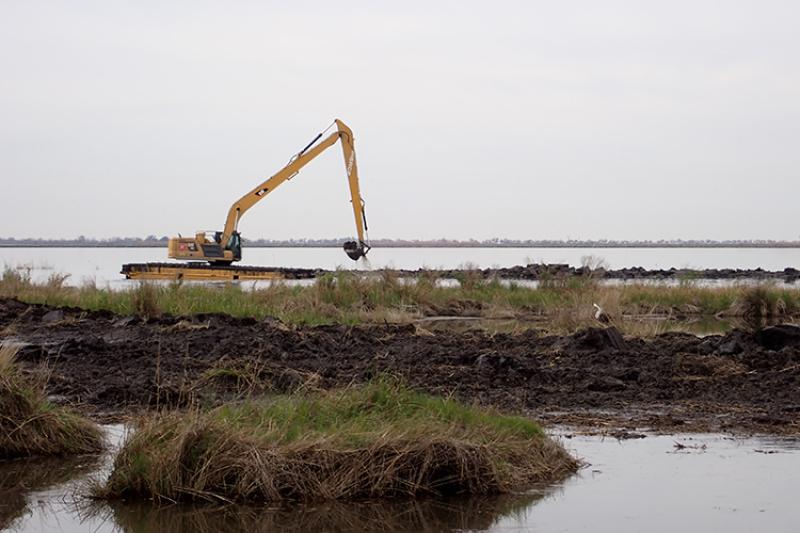Coastal Wetland Restoration
Coastal wetland restoration is a critical climate solution that leverages natural ecosystems to mitigate climate change impacts, reduce flooding, and sequester carbon. This page explores the progress, challenges, and future directions of coastal wetland restoration efforts.

Image of NOAA's Largest Wetland Restoration Project Underway in Louisiana
View open jobs in this Solution
Example Companies
- The Nature Conservancy - Global conservation organization working on coastal wetland protection and restoration.
- Wetlands International - Non-profit dedicated to the conservation and restoration of wetlands.
- Environmental Defense Fund - Focuses on using science and economics to solve environmental problems, including coastal protection.
- Restore America's Estuaries - Alliance of coastal conservation organizations dedicated to protecting and restoring coastal habitats.
- Conservation International - Environmental organization working on nature-based solutions, including coastal ecosystem protection.
Overview
Coastal wetland restoration involves rehabilitating degraded wetland ecosystems to enhance their natural ability to store carbon, reduce wave energy, and mitigate flooding. These ecosystems serve as critical buffers against climate change impacts while providing numerous ecological benefits.
Progress Made
Significant advancements have been made in coastal wetland restoration:
- Green Infrastructure: Development of nature-based solutions for coastal protection.
- Living Shorelines: Creation of stabilized coastal edges using plants, sand, and rock.
- Wetland Restoration Techniques: Improved methods for rehabilitating degraded wetlands.
Solutions by Sector
Conservation
- Protected Areas: Establishing and managing coastal protected areas.
- Ecosystem-Based Management: Implementing holistic approaches to coastal management.
- Blue Carbon Projects: Developing projects that leverage coastal ecosystems for carbon sequestration.
Case Studies:
- Louisiana's Coastal Master Plan: Comprehensive approach to restore and protect Louisiana's coast (Coastal Protection and Restoration Authority).
- Mikoko Pamoja Project, Kenya: Community-led mangrove conservation and restoration project (Mikoko Pamoja).
- The Great Marsh Restoration, Massachusetts: Large-scale salt marsh restoration project (The Nature Conservancy).
Engineering
- Hybrid Infrastructure: Combining natural and engineered solutions for coastal protection.
- Sediment Management: Techniques to enhance natural sediment accretion in wetlands.
- Hydrological Restoration: Restoring natural water flows in degraded wetlands.
Case Studies:
- Living Breakwaters, New York: Innovative coastal resilience project combining engineered breakwaters with habitat enhancement (SCAPE).
- Wallasea Island Wild Coast Project, UK: Europe's largest coastal wetland restoration project (Royal Society for the Protection of Birds).
- Beneficial Use of Dredged Material, Netherlands: Using dredged sediment to enhance salt marshes (EcoShape).
Policy and Planning
- Coastal Zone Management: Developing integrated policies for coastal areas.
- Flood Risk Mapping: Creating detailed maps to inform coastal planning.
- Climate Adaptation Strategies: Incorporating wetland restoration into climate adaptation plans.
Case Studies:
- California Coastal Act: Comprehensive legislation for coastal protection and management (California Coastal Commission).
- Bangladesh Delta Plan 2100: Long-term, holistic plan for the Ganges-Brahmaputra-Meghna Delta (Government of Bangladesh).
- New Zealand Coastal Policy Statement: National policy framework for managing coastal environments (Department of Conservation).
Lessons Learned
- Site Selection: Proper site choice is crucial for successful restoration.
- Native Species: Use of native plant species is vital; non-native species can become invasive.
- Natural Processes: Embracing natural processes enhances project success.
- Monitoring: Continuous monitoring and adaptation are essential for long-term success.
Challenges Ahead
- High Costs: Restoration projects can be expensive, hindering widespread adoption.
- Long-term Data: More research is needed on the long-term effectiveness of restoration efforts.
- Public Awareness: There's a lack of understanding about the climate benefits of wetland restoration.
- Sea Level Rise: Accelerating sea level rise threatens many coastal wetlands.
Best Path Forward
- Education: Increase awareness among policymakers and the public about restoration benefits.
- Research: Enhance understanding of restoration techniques and develop improved guidelines.
- Financial Support: Provide incentives for stakeholders to implement restoration projects.
- Monitoring: Implement effective monitoring programs and share findings widely.
- Integrated Approach: Combine wetland restoration with other coastal management strategies.
Image credit: NOAA